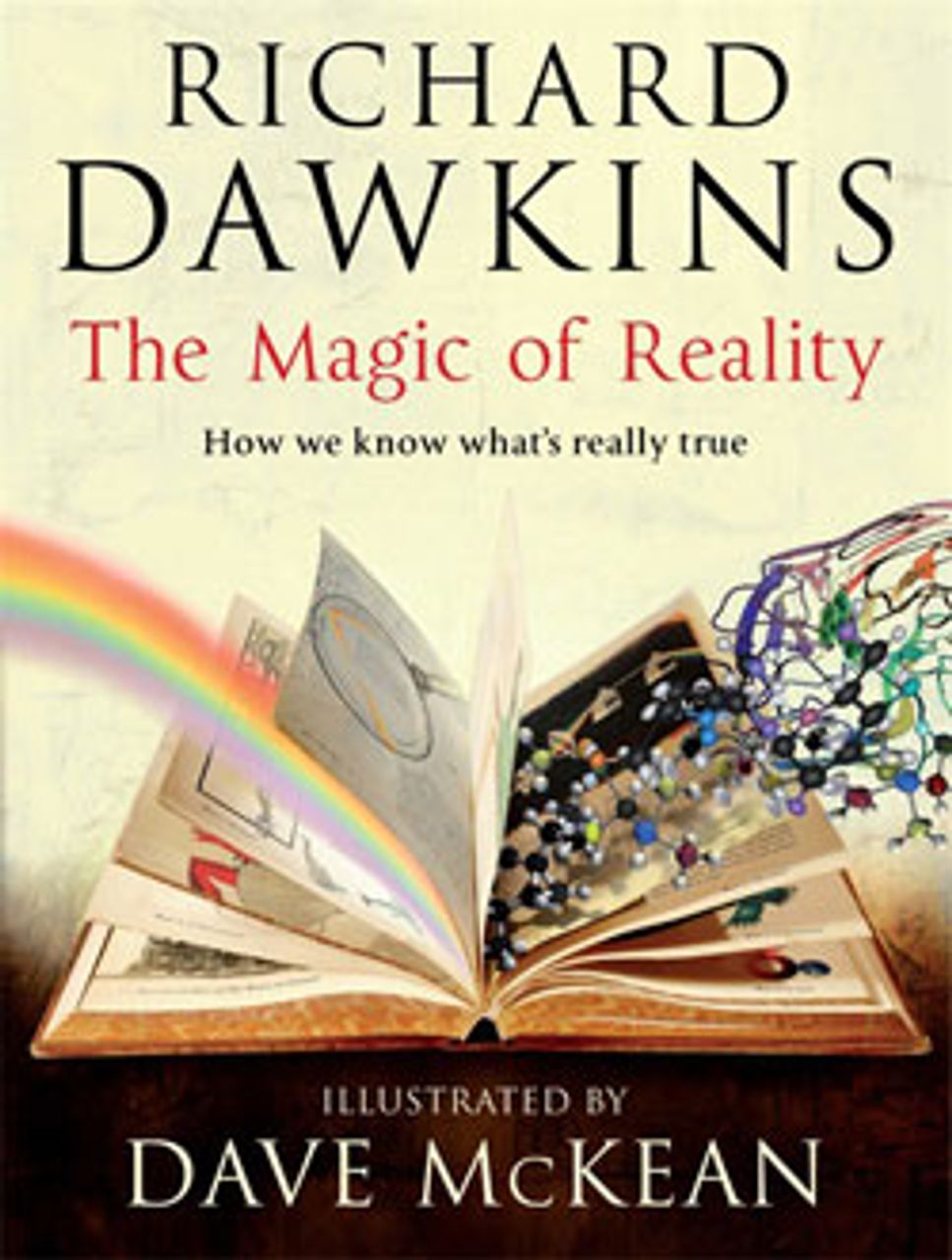Richard Dawkins’ The Magic of Reality: How We Know What’s Really True
By Christine Schofelt

For
more than a decade we have experienced a veritable explosion in the
number of books aimed at young adults and middle schoolers that treat
vampires, witches and other supernatural subjects.
Fantasy, of
course, has its place, but something else, of sociological and
ideological significance, is going on here. There has been a concerted
flight from reality on the part of many authors and publishers—complex
issues of growing up or making sense of the world are increasingly
reduced to good-versus-evil tropes, cloaked in macabre fantasy and
packaged in ways that serve only to remove the reader from the world she
or he inhabits. The search for the next big monster or magical element
is ongoing, and creature after creature is seized upon, trumpeted and
offered up as a trifling distraction.
In this climate, evolutionary biologist Richard Dawkins’ latest offering, The Magic of Reality: How We Know What’s Really True,
is a welcome book indeed. While most people who are familiar with
Dawkins will likely recognize quite a bit of the content from his Unweaving the Rainbow (1998), this is a worthy endeavor, as he shows within its pages why reality offers so much more than fairy tales ever could.

Richard Dawkins
Dawkins
sets out in the first chapter—”What is reality? What is magic?”—to
define the terms in question. He lays out how we know what is real,
through direct sensory perception, as well as by using instruments and
methods to test theories using models, arguing that how we know things
ultimately comes down to reliance on our senses.
Importantly,
he asks, “Does this mean that reality only contains things that can be
detected, directly or indirectly, by our senses and by methods of
science? What about things like jealousy and joy, happiness and love?
Are these not also real?” His answer is firmly materialist; “Yes, they
are real. But they depend for their existence on brains … These emotions
are intensely real to those who experience them, but they didn’t exist
before brains did.” This alone is refreshing.
As for magic, it is
as he notes, “a slippery word,” and Dawkins takes pains to define what
exactly he means by it in this book. While providing examples of
supposedly “supernatural magic” and “stage magic” too (including
references to his friends Penn Jillette and James Randi), by far the
most intriguing discussion involves what he calls “poetic magic”—the
magic of viewing the stars, the magic of being “moved to tears by a
beautiful piece of music,” of “something that makes us feel more alive.”
In
one of my favorite passages, Dawkins provides a very useful warning
against using supernatural magic as an explanation: “To say that
something happened supernaturally is not just to say ‘We don’t
understand it’ but to say ‘We will never understand it, so don’t even
try.’” Science, he says, takes the opposite approach, and “thrives on
its inability—so far—to explain everything, and uses that as a spur to
go on asking questions.”
Opening the doors to inquiry and discovery, to finding out what is real, and encouraging young people to explore the wonders of reality are Dawkins’ primary aims with The Magic of Reality,
and he proves an engaging writer for the vast majority of the book. He
writes with an excitement not often seen in nonfiction books aimed at
people in this age group. His own love of the complexity of reality is
palpable. Where many books on science tend to focus only on the facts,
Dawkins’ approach is very personal and warm. His assumption of
intelligence on the part of the reader, and that we deserve to know the
truth and will enjoy it, is endearing and caring. It matters to him that
young people know what’s what.
Each of the chapters poses and
answers a question—in the second chapter, for example, “Who was the
first person?” Dawkins uses a similar device to his “library” of time in
Unweaving the Rainbow—this time using an imaginary three miles
of photographs to describe the millennial pace of evolution. Tracing
our ancestry back, Dawkins brings us from modern humans through 185
million generations of “great grandparents” to prehistoric fish. Having
started the chapter with a couple of examples of creation myths, which
Dawkins tells in a surprisingly even-handed tone, he then contrasts the
reality and how we know what we know.
The chapter does get
complex, describing several sorts of science involved in figuring out
the process of evolution. This is better than fine, but could get
daunting for some children. The illustrations by Dave McKean, however,
provide a good hook to keep the reader on track.
McKean, whose own
career has ranged over quite a variety of projects, from the Sandman
comic books and film direction to book and album illustration, is a
perfect match for this project. His use of ink drawings, paintings,
photography and collage is not just beautiful, but serves to draw the
reader in—the “what is that?” effect of many of the illustrations is itself a spur to deeper attention and thought.
Moving
through the subjects of atoms, earthquakes, the sun and (of course)
rainbows, Dawkins then tackles such questions as “Are we alone?” “Why do
bad things happen?” and “What is a miracle?” It is here that one can
expect trouble from certain quarters, because while Dawkins’ tone
remains avuncular, his content will not sit well with some.
In
“Are we alone?,” Dawkins notes that there are not many ancient legends
involving aliens, and therefore discusses more modern phenomena such as
the Heaven’s Gate cult. He treats the victims of the cult humanely, with
an effort to explain why they took the actions they did. He is very
good in this chapter, which covers the gamut of alien abduction stories,
and brings in the studies of a number of psychologists on subjects such
as how memory works, false memory syndrome, sleep paralysis and such.
His
efforts to debunk alien abduction tales are not intended to discontinue
the search for knowledge—indeed, it is just a jumping off point. In
answer to the question, “Is there really life on other planets?,” he
answers flatly, “Nobody knows. If you forced me to give an opinion one
way or the other, I’d say yes … But who cares about an opinion? One of
the great virtues of science is that scientists know when they don’t
know the answer to something. They cheerfully admit that they don’t
know. Cheerfully, because not knowing the answer is an exciting
challenge to try to find it.”
“Why do bad things happen?” is a
very useful chapter in which Dawkins not only sets out to make sense of
superstition, but also to show what “luck” really is, and to
“depersonalize” the universe. As in the other chapters, Dawkins makes
good use of myths and stories of ancient traditions to introduce the
chapter and illustrate his points, and we see in this section an
especially welcome tendency not to condemn, but to understand why people
thought the way they did.
The various myths are treated as past
attempts to understand the world around us and dismissed gently. The
reality of the situation—concepts such as probability, for example—are
introduced. He makes, in every case, a very good argument for science as
a better and more intriguing way to find out about the richness of the
world than any story that has gone before. Gentle as he is, however, he
does firmly place the legends and myths properly to rest, and this is
bound to rile the more rabid elements of various religious communities.
All
in all, this is a valuable book. Dawkins has said that he intended it
for those 12 years old on up—but that he also hoped parents would read
it with their kids. One could certainly see curling up with it.
No hay comentarios:
Publicar un comentario